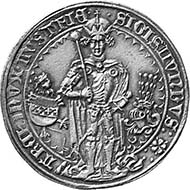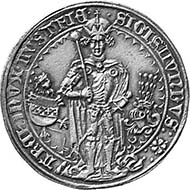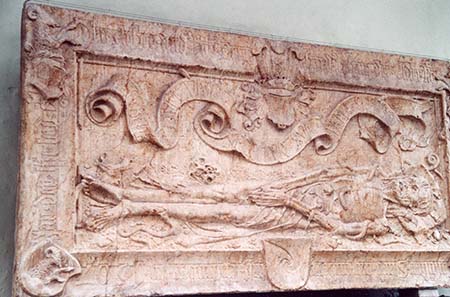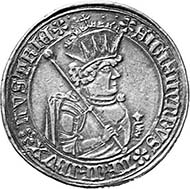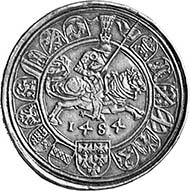What is left of the man who invented the taler
By
Today’s visitor of the Hall parish church has two options for entering the churchyard. In case he chooses the portal which leads him directly from the town square to the church he immediately discovers, to his left near the church yard’s wall, the tombstone of a man who, in his function as mint master, accompanied one of the most important revolutions in minting.
Archduke Sigismund Rich in Coin, 1477-1496. Guldiner 1486, Hall. From auction Münzen und Medaillen AG 91 (2001), 795.
It was under Bernhard Beheim the Elder, whose tomb so many tourists of the city of Hall pass without taking further notice, that the first guldiner were minted, the big silver coins that were issued by Duke Sigismund Rich in Coin who had silver in abundance. These pieces with their weight being related to the gold gulden, whose silver equivalent they were designed to be, became the predecessor of the most common trade coin of early modern times, the taler.
The tomb of the mint master Bernhard Beheim the Elder. Photograph: Ursula Kampmann.
His tomb shows Bernhard Beheim in the style of the Renaissance, in a sheer garment, his halfway rotten body eaten up by bugs, snakes, toads and snails. This pitiful representation was considered appropriate by early modern artists to visualize the horror of death and to state the human body gets into after death, in contrast to the undying soul. To the modern viewer that may seem odd since the sepulchral marker hardly betrays what important man it covers.
Archduke Sigismund Rich in Coin, 1477-1496. Dickguldiner of the half guldiner die 1484, Hall. From auction Münzen und Medaillen AG 91 (2001), 794.
Bernhard Beheim the Elder was the person responsible for minting the gold coins of Sigismund Rich in Coin of Tyrol before he was appointed mint master in 1482 of the Hall Mint which had been established not long before, in 1477. Back then, he received an annual salary of 200 Mark and supervised roughly 20 employees. Bernhard Beheim seems to have been an innovative craftsman who, together with the executive senior civil servant of Sigismund, Anton vom Roß, was the leading figure in conducting the Tyrolean currency reform. After “inventing” the “pfundner”, a coin worth 12 kreuzer, and the sechser, a coin of 6 kreuzer, a silver coin was designed worth 30 kreuzer or half a gold gulden and shortly afterwards the guldiner.
Bernheim was an important associate not only of Sigismund but, after the latter’s resignation, of Maximilian, too. In 1492, for example, his master sent him to Strasburg to safeguard his interests on a coin inspection day there. Beheim was the mints’ head for 25 years, until his death in 1507. Maximilian being very satisfied with his mint master, he conferred the father’s office to the son, Bernhard Beheim the Younger.
Bernhard Beheim was buried in Hall. His tomb should be a memento mori to all coin friends: no matter what big a feat you do for numismatics, one day you will be lying, too, forgotten and disregarded like Bernhard Beheim, creator of the taler.
Did this article arouse your interest in the city of Hall? There you can particpate in a mint trip. If you are interested please click here.







